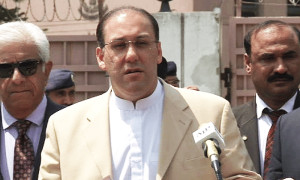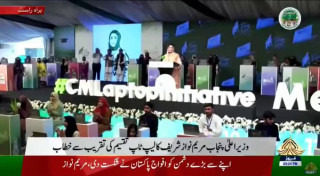amir_ali
Chief Minister (5k+ posts)
[h=2]Sunshine-rich GCC countries are investing billions in solar-powered energy.
Sam Bollier Last updated: 23 Jan 2014 09:29[/h]

Abu Dhabi, United Arab Emirates - On the edge of the Arabian Peninsula's desolate Empty Quarter, hundreds of thousands of curved mirrors lined up in neat rows are quietly making electricity.
Sunlight bounces off the mirrors, which concentrate the rays to heat up a specially made liquid to almost 400 degrees Celsius. The scalding oil is then used to generate steam, which turns turbines that create electricity for about 20,000 homes in the United Arab Emirates (UAE).
This is Shams 1, the biggest single-unit concentrated solar power plant in the world when it opened last year. The idea behind concentrated solar isn't new: During the siege of Syracuse in 3rd century BC, the Greek inventor Archimedes was said to have used mirrors to focus the sun's rays on the invading Roman fleet, setting the ships on fire. (Perhaps as revenge for the stunt, Archimedes was killed by Roman soldiers after they won the siege.)
What is new is that oil-rich Middle Eastern countries - especially those in the Gulf region - have become increasingly bullish on solar power, in a bid to diversify their energy supply and perhaps turn a profit in the process.
For the Gulf's solar industry, 2013 was a year of firsts: In addition to the opening of Abu Dhabi's Shams 1 plant, Dubai's first solar power plant became operational, and Kuwait and Oman decided to build their first as well. In Saudi Arabia, one energy analyst found the cost of generating electricity from solar there had become as cheap as generating electricity from oil-fired power plants.
Saudi's solar goals appear to be the most gung-ho in the region: The kingdom has announced that it plans to throw down $109bn on solar energy and get one-third of its power from the sun by 2032. This target is "too ambitious", said Hussam Khonkar of Saudi Arabia's King Abdulaziz City for Science and Technology, but added the technology to do so is available.
Plummeting prices
So why now? "Before 2008, the cost of renewable generation was too high," said Yousif al-Ali, the general manager of Shams Power, which runs the Shams 1 plant. But in recent years, despite the global recession, Chinese companies manufactured huge amounts of photovoltaic solar panels. Now, said Ali, the cost of generating electricity from photovoltaic solar plants is in many cases as cheap as electricity generated by diesel.
You're seeing countries like UAE make substantial investments in renewables because they realise that clean energy is going to be one of the largest growth industries of the 21st century.
Just in the past five years, the price of photovoltaic panels has fallen by about 75 percent, according to Amit Ronen, the director of the George Washington University Solar Institute. This will make solar power more appealing in places where it wasn't previously thought affordable. "In 2014 and beyond, you're going to see a lot of new countries responding to these new economics around solar photovoltaic plants," said Matthew Campbell, senior director of SunPower, a US solar energy company.
Energy policymakers in the region realise the flush times won't last forever. At first glance, it's hard to take too seriously the energy issues faced by the Gulf countries, which have long stood among the world's biggest exporters of oil and natural gas. But the future doesn't look as sunny to those who worry their countries are at risk of squandering their geological inheritance.
'Systemic waste'
A 2013 report by London-based think-tank Chatham House detailed what it described as "systemic waste of natural resources" in the Gulf countries. If current trends continue, Saudi Arabia could be using all its oil production domestically in 15 years, said Khonkar.
Because petrol in the Gulf countries is subsidised at bargain-basement prices, a significant portion of the oil produced ends up in the fuel tanks of big SUVs at home. Because desalinated water is also provided to residents at low cost, the countries are among the most prodigious users of water in the world - which also takes a toll on fuel supplies. Because more workers are brought into the region each year to build infrastructure and staff the service industry, the demand for energy has continued to ratchet up.
Yet luckily for them, the Gulf's oil-rich countries are even more sun-rich. The Arabian Peninsula is among the sunniest places in the world, ranking alongside other solar hotspots such as Arizona and parts of South America's Andes Mountains. A single square kilometre of land in Qatar receives as much solar energy in one year as is contained in 1.5 million barrels of oil, according to one study.
Exporting clean energy
The UAE has been the most proactive in the region in promoting alternative energy. Its government said it plans on spending $350m on renewable energy projects in developing countries, and its capital, Abu Dhabi, hosts the International Renewable Energy Agency.
In recent years, the Abu Dhabi Fund for Development and Masdar, a clean energy company owned by Abu Dhabi's government, have developed and funded a major solar plant in Mauritania, a wind farm in the Seychelles, and planto launch renewable energy projects in five Pacific island states as well.
The price of photovoltaic panels has fallen by 75 percent [Reuters]
Self-interest is one factor driving the country's policy. "You're seeing countries like UAE make substantial investments in renewables because they realise that clean energy is going to be one of the largest growth industries of the 21st century," said Ronen. "And they want to get in the game."
But is it 'green'?
Reports of solar energy's spread in the Gulf would seem to be heartening news to environmentalists. If even major oil exporters are planning large-scale alternative energy projects, surely there's hope that global climate change can be curbed before it's too late?
On the other hand, it may be facile to assume that a potential solar bonanza in the Gulf will necessarily be a green one. With crude oil selling for more than $100 a barrel in recent years, exporters may figure they can make more money if they use less of the stuff at home, and sell more abroad.
Developing more renewable energy capacity will allow the Gulf countries to "keep making money exporting their oil and natural gas and create more jobs at home", said Ronen. "It's not like the natural gas is staying in the ground because of the solar."
As economist Jeffrey Sachs noted this week at the International Renewable Energy Agency's annual assembly in Abu Dhabi, it's not enough merely to develop alternative sources of energy: In order to limit global warming, one also has to limit the use of fossil fuels.
In the post-Fukushima era, some environmentalists may also recoil at another strategy considered by some Gulf states to diversify their energy supply: nuclear power. Saudi Arabia is considering building several nuclear reactors that could cost up to $100bn, and the UAE plans on having four plants operational by 2020.
http://www.aljazeera.com/indepth/fe...-solar-powered-future-201412363550740672.html
Sam Bollier Last updated: 23 Jan 2014 09:29[/h]

Abu Dhabi, United Arab Emirates - On the edge of the Arabian Peninsula's desolate Empty Quarter, hundreds of thousands of curved mirrors lined up in neat rows are quietly making electricity.
Sunlight bounces off the mirrors, which concentrate the rays to heat up a specially made liquid to almost 400 degrees Celsius. The scalding oil is then used to generate steam, which turns turbines that create electricity for about 20,000 homes in the United Arab Emirates (UAE).
This is Shams 1, the biggest single-unit concentrated solar power plant in the world when it opened last year. The idea behind concentrated solar isn't new: During the siege of Syracuse in 3rd century BC, the Greek inventor Archimedes was said to have used mirrors to focus the sun's rays on the invading Roman fleet, setting the ships on fire. (Perhaps as revenge for the stunt, Archimedes was killed by Roman soldiers after they won the siege.)
What is new is that oil-rich Middle Eastern countries - especially those in the Gulf region - have become increasingly bullish on solar power, in a bid to diversify their energy supply and perhaps turn a profit in the process.
For the Gulf's solar industry, 2013 was a year of firsts: In addition to the opening of Abu Dhabi's Shams 1 plant, Dubai's first solar power plant became operational, and Kuwait and Oman decided to build their first as well. In Saudi Arabia, one energy analyst found the cost of generating electricity from solar there had become as cheap as generating electricity from oil-fired power plants.
Saudi's solar goals appear to be the most gung-ho in the region: The kingdom has announced that it plans to throw down $109bn on solar energy and get one-third of its power from the sun by 2032. This target is "too ambitious", said Hussam Khonkar of Saudi Arabia's King Abdulaziz City for Science and Technology, but added the technology to do so is available.
Plummeting prices
So why now? "Before 2008, the cost of renewable generation was too high," said Yousif al-Ali, the general manager of Shams Power, which runs the Shams 1 plant. But in recent years, despite the global recession, Chinese companies manufactured huge amounts of photovoltaic solar panels. Now, said Ali, the cost of generating electricity from photovoltaic solar plants is in many cases as cheap as electricity generated by diesel.
You're seeing countries like UAE make substantial investments in renewables because they realise that clean energy is going to be one of the largest growth industries of the 21st century.
Just in the past five years, the price of photovoltaic panels has fallen by about 75 percent, according to Amit Ronen, the director of the George Washington University Solar Institute. This will make solar power more appealing in places where it wasn't previously thought affordable. "In 2014 and beyond, you're going to see a lot of new countries responding to these new economics around solar photovoltaic plants," said Matthew Campbell, senior director of SunPower, a US solar energy company.
Energy policymakers in the region realise the flush times won't last forever. At first glance, it's hard to take too seriously the energy issues faced by the Gulf countries, which have long stood among the world's biggest exporters of oil and natural gas. But the future doesn't look as sunny to those who worry their countries are at risk of squandering their geological inheritance.
'Systemic waste'
A 2013 report by London-based think-tank Chatham House detailed what it described as "systemic waste of natural resources" in the Gulf countries. If current trends continue, Saudi Arabia could be using all its oil production domestically in 15 years, said Khonkar.
Because petrol in the Gulf countries is subsidised at bargain-basement prices, a significant portion of the oil produced ends up in the fuel tanks of big SUVs at home. Because desalinated water is also provided to residents at low cost, the countries are among the most prodigious users of water in the world - which also takes a toll on fuel supplies. Because more workers are brought into the region each year to build infrastructure and staff the service industry, the demand for energy has continued to ratchet up.
Yet luckily for them, the Gulf's oil-rich countries are even more sun-rich. The Arabian Peninsula is among the sunniest places in the world, ranking alongside other solar hotspots such as Arizona and parts of South America's Andes Mountains. A single square kilometre of land in Qatar receives as much solar energy in one year as is contained in 1.5 million barrels of oil, according to one study.
Exporting clean energy
The UAE has been the most proactive in the region in promoting alternative energy. Its government said it plans on spending $350m on renewable energy projects in developing countries, and its capital, Abu Dhabi, hosts the International Renewable Energy Agency.
In recent years, the Abu Dhabi Fund for Development and Masdar, a clean energy company owned by Abu Dhabi's government, have developed and funded a major solar plant in Mauritania, a wind farm in the Seychelles, and planto launch renewable energy projects in five Pacific island states as well.
The price of photovoltaic panels has fallen by 75 percent [Reuters]
Self-interest is one factor driving the country's policy. "You're seeing countries like UAE make substantial investments in renewables because they realise that clean energy is going to be one of the largest growth industries of the 21st century," said Ronen. "And they want to get in the game."
But is it 'green'?
Reports of solar energy's spread in the Gulf would seem to be heartening news to environmentalists. If even major oil exporters are planning large-scale alternative energy projects, surely there's hope that global climate change can be curbed before it's too late?
On the other hand, it may be facile to assume that a potential solar bonanza in the Gulf will necessarily be a green one. With crude oil selling for more than $100 a barrel in recent years, exporters may figure they can make more money if they use less of the stuff at home, and sell more abroad.
Developing more renewable energy capacity will allow the Gulf countries to "keep making money exporting their oil and natural gas and create more jobs at home", said Ronen. "It's not like the natural gas is staying in the ground because of the solar."
As economist Jeffrey Sachs noted this week at the International Renewable Energy Agency's annual assembly in Abu Dhabi, it's not enough merely to develop alternative sources of energy: In order to limit global warming, one also has to limit the use of fossil fuels.
In the post-Fukushima era, some environmentalists may also recoil at another strategy considered by some Gulf states to diversify their energy supply: nuclear power. Saudi Arabia is considering building several nuclear reactors that could cost up to $100bn, and the UAE plans on having four plants operational by 2020.
http://www.aljazeera.com/indepth/fe...-solar-powered-future-201412363550740672.html
































